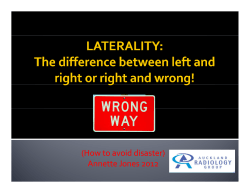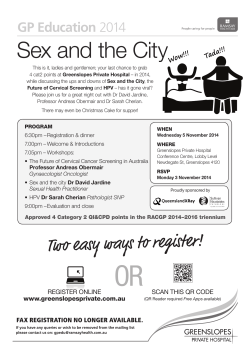
Cervical spine
Cervical spine Cervical Spine Anatomy Cervical Spine Anatomy 1 2 Vertebrae (7) • Intervertebral discs (6) • Pairs of exiting nerve • roots (8) 3 4 5 6 7 Cervical lordosis Occ-C7 averages 40° Most of the lordosis occurs – at the C1-C2 segment • Cervical Spine Anatomy Approximately 50% of flexion- • extension motion occurs at occiput-C1 Approximately 50% of rotation • occurs at C1-C2 Lesser amounts of flexion- • extension, rotation, and lateral bending occur segmentally between C2-C7 Cervical Spine Anatomy Inferior Superior Atypical vertebral • structure C1 (atlas) • Vertebral canal/foramen • Anterior arch • Anterior tubercle • Transverse process • Posterior arch • Transverse foramen • Lateral mass • Cervical Spine Anatomy anterior view posterior view Atypical cervical • vertebra C2 (axis) • Odontoid process or dens • Vertebral canal/foramen • Facet joints • Transverse process • Transverse foramen • Bifid spinous process • Lamina • Cervical Spine Anatomy The odontoid process of • the axis (C2) extends cranially to form the axis of rotation with atlas (C1) Cervical Spine Anatomy Ligaments • Anterior longitudinal – ligament Posterior longitudinal – ligament Ligamentum flavum – Intertransverse ligaments – Interspinous ligaments – Ligamentum nuchae – Cervical Spine Anatomy Ligaments • Anterior longitudinal – ligament Posterior longitudinal – ligament Ligamentum flavum – Intertransverse ligaments – Interspinous ligaments – Ligamentum nuchae – Cervical Spine Anatomy Ligaments • Anterior longitudinal – ligament Posterior longitudinal – ligament Ligamentum flavum – Intertransverse ligaments – Interspinous ligaments – Ligamentum nuchae – Cervical Spine Anatomy Ligaments • Anterior longitudinal – ligament Posterior longitudinal – ligament Ligamentum flavum – Intertransverse ligaments – Interspinous ligaments – Ligamentum nuchae – Cervical Spine Anatomy Ligaments • Anterior longitudinal – ligament Posterior longitudinal – ligament Ligamentum flavum – Intertransverse – ligaments Interspinous ligaments – Ligamentum nuchae – Cervical Spine Anatomy Neural elements• 8 pair of cervical nerves – Exit the spinal canal – superior to the vertebrae for which they are numbered C1 nerves exit the • canal between Occ & C1 C2 nerves exit the • canal between C1 & C2 C8 nerves exit the • canal between C7 & T1 Torticollis 1ry,2ndary Cause and discription Infantile (congenital) torticollis • -common. The sternomastoid muscle on one side is • fibrous and fails to elongate as the child grows; consequently, progressive deformity develops. The cause is unknown; the muscle may have suffered • ischaemia from a distorted position in utero ( breech • presentation and hip dysplasia ), or it may have been injured at birth Clinical feature -Hx-difficult labour or breech delivery • O/E –lump- there is neither deformity nor obvious • limitation of movement - months the lump disapear -----Deformity does not become apparent untilthe child is 1–2 years old. The head is tilted to on one side, so – that the ear approaches the shoulder; the -sternomastoid on that side may feel tight and hard. • -There may also be asymmetrical development of the • face (plagiocephaly). become increasingly obvious as • the child grows DDX lymphadenitis - • -bony anomalies, • -discitis, • X_RAY • Treatment -If the diagnosis is made during infancy-daily muscle – stretching by the aparents may prevent the deformity. -If the condition persists beyond one year, operative correction is required -usually at its lower end but sometimes at the upper end or at both ends) and the head is manipulated • into the neutral position. After operation, correction • must be maintained, with a temporary rigid • orthosis followed by stretching exercises. • Secondary torticollis infection (lymphadenitis, retropharyngeal • abscess, tonsillitis, discitis, tuberculosis), trauma, • juvenile rheumatoid arthritis, posterior fossa • tumours, intraspinal tumours, dystonia (benign • paroxysmal torticollis) or ocular dysfunction. • Cervical disc degeneration Cervical disc prolapse- • CERVICAL SPONDYLOSIS- • Cervical spondolytic myelopathy • -ossification of posterior longitudinal ligament, – cervical spinal canal stenosis-- • Intervertebral Disc Hydrostatic, load bearing structure between the vertebral bodies Nucleus pulposus + annulus fibrosus • No blood supply • L4-5, largest avascular structure in the body • • Nucleus Pulposus Type II collagen strand + hydrophilic proteoglycan • Water content 70 ~ 90% • Confine fluid within the annulus • Convert load into tensile strain on the annular • fibers and vertebral end-plate Annulus Fibrosus Outer boundary of the disc • More than 60 distinct, concentric layer of • overlapping lamellae of type I collagen Helicoid pattern • Resist tensile, torsional, and radial stress • Attached to the cartilaginous and bony end-plate at the periphery of the vertebra • Vertebral End-Plate Cartilaginous and osseous component • Nutritional support for the nucleus • Passive diffusion • Facet Joint Synovial joint • Rich innervation with sensory nerve fiber • Same pathologic process as other large synovial joint • Load share 18% of the lumbar spine • Vital Functions -Restricted intervertebral joint motion • -Contribution to stability and- • Preservation of anatomic relationship -Resistence to axial, rotational, and bending load Nerve root • Medial & inferior to the pedicle at each level • More susceptiple for mechanical deformation fig Cervical disc prolapse Introduction • • • • Male predominance 30 – 50 yrs Smokers Sudden flexion& Twisting Intervertebral Disc Cellular and Biochemical Change Decrease proteoglycan content • Water loss within the nucleus pulposus • Decrease hydrostatic property • Loss of disc height • Uneven stress distribution on the annulus • Classification • A-Site;5-6,6-7 • B-Direction; posterolat • C-Amount ---Bulge --Herniation 1-Protrusion 2-extrusion 3- sequestration Clinical picture Pressure on pll • --------------- Dura Pressure on root Pressure on cord Mixed • • • • EXAM LOOK • FEEL • MOVE • NEUROLLOGICAL EXAM • SPECIAL TEST – -neck compression,distraction,valsava – Imaging • X-ray • MRI • CT scans with or without myelography -intolerant to MRI -Unsuitable for MRI • gadolinium-enhanced MRI This will help to delineate which part of the previous operation site is disc and which is epidural fibrosis (the latter enhancing). DDX Acute muscular&ST • strain Infection Tumor Rotator cuff syndrome • • Treatment • usually have a good prognosis • . In up to four-fifths of patients, symptoms will resolve spontaneously within a 12-week period. • However, if pain persists beyond this time there is a slow resolution of pain in the majority of patients. • By approximately 4 years there is no difference in the incidence of pain in patients treated non-operatively or surgically. • Surgical results will deteriorate after symptoms have been present for 1 year. -REST-collar ANALGESICS&ANTIINFLAMATORY • ---Reduce-traction ----Remove -Rhablitate Epidural steroid injection If pain persist beyond 4 weeks • Maximum 3 injection per year • Indications for diskectomy • Strong indications for surgical intervention -Acute mylopathy or myloradiculopathy -Progressive Neurological deficit • Relative indications • Failure of conservative treatment-refractory • Significant motor deficit • Severe incapacitating pain - does not respond to any form of treatment surgical treatment --Microdiscectomy --Chemonucleolysis with Ozon, Chymopapain ----Automated Percutaneous Nucleotomy ---Manual Percutaneous Discectomy • --Percutaneous Laser Discectomy-- • --Diskectomy plus fusion • -- Diskectomy plus Vertebral arthroplasty •
© Copyright 2025














